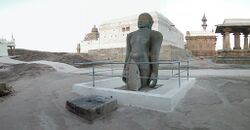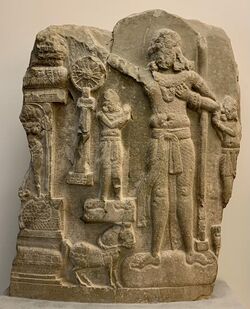Philosophy:Chakravarti (Sanskrit term)
| Chakravarti |
|---|
A chakravarti (Sanskrit: चक्रवर्तिन्, romanized: cakravartin) is an ideal (or idealized) universal ruler, in the history, religion, and mythologies of India. The concept is present in Indian subcontinent cultural traditions, narrative myths and lore.[1] There are three types of chakravarti: chakravala chakravarti, an emperor who rules over all four of the continents (i.e., a universal monarch); dvipa chakravarti, a ruler who governs only one of those continents; and pradesha chakravarti, a monarch who leads the people of only a part of a continent, the equivalent of a local king.[2] Dvipa chakravarti is particularly one who rules the entire Indian subcontinent (as in the case of the Mauryan Empire despite never conquering the Kings of Tamilakam ).[3]:175 The first references to a Chakravala Chakravartin appear in monuments from the time of the early Maurya Empire, in the 4th to 3rd century BCE, in reference to Chandragupta Maurya and his grandson Ashoka.
In Buddhism, a chakravarti is the secular counterpart of a buddha. The term applies to temporal as well as spiritual kingship and leadership, particularly in Buddhism and Jainism. In Hinduism, a chakravarti is a powerful ruler whose dominion extends to the entire earth. In both religions, the chakravarti is supposed to uphold dharma, indeed being "he who turns the wheel (of dharma)".
The Indian concept of chakravarti later evolved[citation needed] into the concept of devaraja – the divine right of kings – which was adopted by the Indianised Hindu-Buddhist kingdoms of Southeast Asia through Hindu Brahmin scholars deployed from India to their courts. It was first adopted by Javanese Hindu-Buddhist empires such as Majapahit; through them by the Khmer Empire; and subsequently by the Thai monarchs.[citation needed]
Hinduism
According to the traditions "Vishnu, in the form of Chakra, was held as the ideal of worship for Kings desirous of obtaining Universal Sovereignty",[4]:48 a concept associated with the Bhagavata Puranas, a religious sanction traceable to the Gupta period,[5] which also led to the chakravartin concept.[4]:65 There are relatively few examples of chakravartins in both northern and southern India.
Bharata, the son of Dushyanta and Shakuntala, was conferred the title of cakravartin samrāj, according to some legends. Another emperor of the same name, who was the son of Rishabha, was also given the title cakravartin.
In Southern India, the Pallava period beginning with Simhavishnu (575–900 CE) was a transitional stage in southern Indian society with monument building, establishment of (bhakti) sects of Alvars and Nayanars, flowering of rural Brahmanical institutions of Sanskrit learning, and the establishment of Chakravartin model of kingship over a territory of diverse people; which ended the pre-Pallavan era of territorially segmented people, each with their culture, under a tribal chieftain.[6] The Pallava period extolled ranked relationships based on ritual purity as enjoined by the shastras.[7] Burton distinguishes between the Chakravatin model and the Kshatriya model, and likens kshatriyas to locally based warriors with ritual status sufficiently high enough to share with Brahmins; and states that in south India the kshatriya model did not emerge.[7] As per Burton, South India was aware of the Indo-Aryan Varna organized society in which decisive secular authority was vested in the Kshatriyas; but apart from the Pallava, Chola and Vijayanagar line of warriors which claimed Chakravartin status, only few locality warrior families achieved the prestigious kin-linked organization of northern warrior groups.[7]
Jainism

During the each motion of the half-cycle of the wheel of time, 63 Salakapurusa or 63 illustrious men, consisting of the 12 Chakravartin regularly appear.[8] The Jain cosmology or legendary history is basically a compilation of the deeds of these illustrious men. As per Jain cosmology, Chakravartins are Universal Monarchs or World Conquerors. Golden in complexion, they all belonged to the Kasyapa gotra. The mother of a Chakravartin sees some dreams at the time of conception. A chakravartin is considered an ideal human being endowed with thirty-two major signs of excellence and many minor signs of excellence.
The list of 12 chakravartin of Avasarpini as per Jainism is as follows[9]
- Bharata, son of Tirthankara Rishabhanatha
- Sagara, ancestor of Bhagiratha as in the Puranas
- Maghava[10]:306
- Sanatkumara[10]:306
- Tirthankara Shantinatha
- Tirthankara Kunthunatha[10]:308
- Tirthankara Aranatha[10]:308
- Subhauma[10]:308
- Padmanabha
- Harishena
- Jayasena
- Brahmadatt
In Jainism, a Chakravartin Samrat was characterised by his possession of Saptaratna, or "Seven Jewels":[citation needed]
- Ratna-Chakra, a miraculous diamond serrated discus that never misses its target
- Empress
- Divine Jewellery
- Immense Wealth
- Huge Army of War-Chariots
- Huge Army of Cavalry
- Huge Army of Elephants
Some lists cite navaratna or "nine jewels" instead, adding "Prime Minister" and "Son".[citation needed]
Buddhism
It was believed that once a chakravarti emerged the "Future Buddha" Maitreya would appear on earth.[3]:175
In early Buddhist art there are more than 30 depictions, all from the Deccan. In most the Chakravarti King uses the "Royal Gesture" in which the king "clenches his left hand at his chest and reaches up with his right hand". He is surrounded by his seven attributes: the Chakraratna wheel, his state elephant, charger horse, "the octagonal gem which is so luminous it can light the path of his army by night", his queen, defense minister and finance minister.[3]:175–176
The early Buddhist Mahāvastu (1.259f) and the Divyāvadāna, as well as the Theravadin Milindapañha, describe the marks of the chakravarti as ruler: uṣṇīṣa, chhatra "parasol", "horn jewel" or vajra, whisk and sandals. These were the marks of the kshatriya. Plastic art of early Mahayana Buddhism illustrates bodhisattvas in a form called uṣṇīṣin "wearing a turban/hair binding", wielding the mudras for "nonviolent cakravarti rule".[11]

See also
Similar Indic concepts
- Chakraborty
- Chhatrapati
- Devaraja
- Kalachakra
- Maharaja
- Rajamandala
- Samraat
Generic similar concepts
- Philosopher king
- Solar chariot
- Universal monarchy
- King of the Universe
Spread and evolution of Chakravarti concept beyond India
- Greater India
- kingdoms of Southeast Asia
- Indianisation
References
Citations
- ↑ Gopal, Madan (1990). K.S. Gautam. ed. India through the ages. Publication Division, Ministry of Information and Broadcasting, Government of India. p. 81. https://archive.org/details/indiathroughages00mada.
- ↑ "Chakravartin | Indian ruler". Encyclopædia Britannica. https://www.britannica.com/topic/chakravartin.
- ↑ 3.0 3.1 3.2 John M. Rosenfield (1967). "The Dynastic Arts of the Kushans". California Studies in the History of Art (University of California Press). ISSN 0068-5909. https://books.google.com/books?id=udnBkQhzHH4C&pg=PA186.
- ↑ 4.0 4.1 Wayne Edison Begley (1973). Viṣṇu's flaming wheel: the iconography of the Sudarśana-cakra. Monographs on archaeology and fine arts. 27. New York: New York University Press.
- ↑ Śrīrāma Goyala, (1967). A history of the Imperial Guptas, p.137. Central Book Depot.
- ↑ Stein, Burton (1980). Peasant state and society in medieval South India. Oxford University Press. pp. 63–64. https://archive.org/details/peasantstatesoci0000stei.
- ↑ 7.0 7.1 7.2 Burton Stein (1980). Peasant state and society in medieval South India. Oxford University Press. p. 70. https://archive.org/details/peasantstatesoci0000stei.
- ↑ Wendy Doniger, ed (1999). "Encyclopedia of World Religions". Encyclopedia of World Religions. Merriam-Webster. p. 550. ISBN 0-87779-044-2. https://books.google.com/books?id=ZP_f9icf2roC.
- ↑ Jaini, Jagmanderlal, F.W. Thomas, ed., Outlines of Jainism appendix III.
- ↑ 10.0 10.1 10.2 10.3 10.4 Helmuth von Glasenapp (1999). Jainism: An Indian Religion of Salvation. Delhi: Motilal Banarsidass. ISBN 81-208-1376-6. https://books.google.com/books?id=WzEzXDk0v6sC.
- ↑ Harry Falk (2012). "Small-Scale Buddhism". Devadattīyam: Johannes Bronkhorst Felicitation Volume. Bern: Peter Lang. p. 495. ISBN 9783034306829.
Sources
- Dictionary of Hindu Lore and Legend (ISBN:0-500-51088-1) by Anna Dallapiccola
- Cakkavatti Sutta The Wheel-turning Emperor (excerpt) Translated from the Pali by Thanissaro Bhikkhu
- A Glossary of Pali and Buddhist Terms
 |




